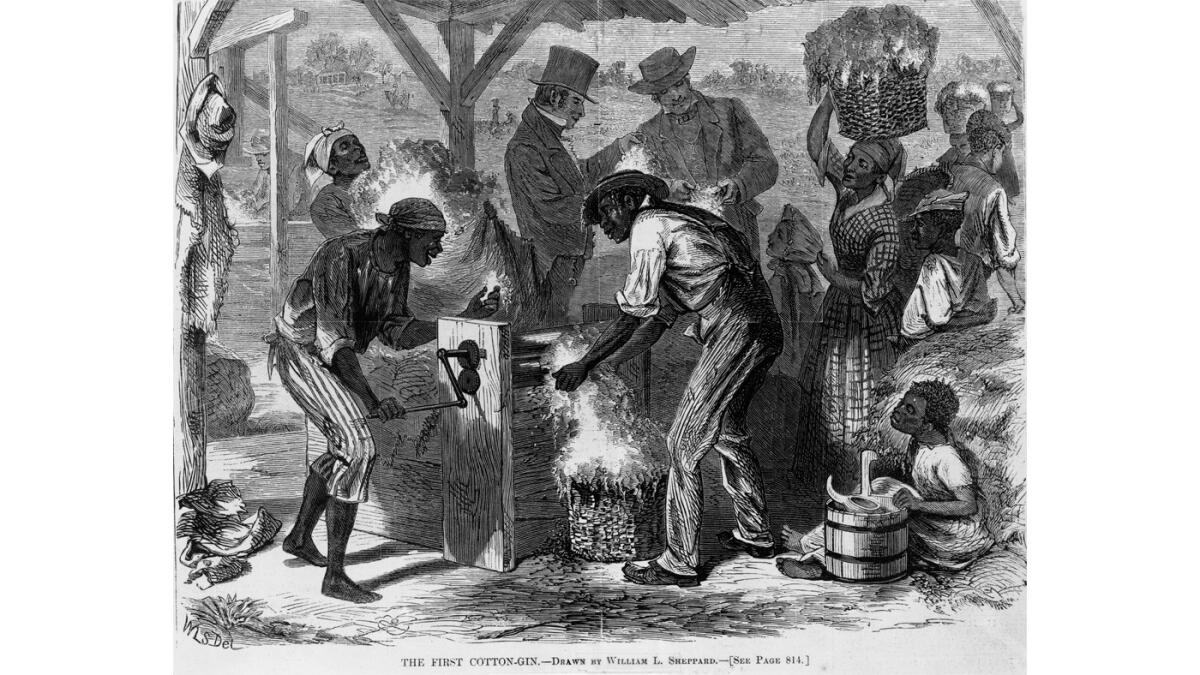Review: ‘The Half Has Never Been Told’ looks at the economics of slavery

The image of the genteel, benevolent Southern slave owner was the creation of early 20th century artists and writers like D.W. Griffith and Margaret Mitchell. Life on the antebellum plantation, they led us to believe, was as languid as a slow-moving river winding through magnolia trees.
At about the same time, American historians were writing the first analyses of slave-centered Southern society. Slavery was an economically inefficient institution, they argued. For slave owners, profit was a secondary concern. Being lord of the manor was its own reward.
In “The Half Has Never Been Told: Slavery and the Making of American Capitalism,” Cornell professor Edward E. Baptist makes a persuasive case that slavery wasn’t like that at all. Plantations (“slave labor camps,” he calls them) were run with the ruthless efficiency of your average sweatshop. This ambitious new economic and social history of antebellum America suggests that the bondage of African Americans is just another chapter in the rise of the global economy.
The cotton boom that started just after 1800 changed the American economy, Baptist argues. Before then, slavery was in decline. But with the spread of the Industrial Revolution, cotton became the world’s most traded commodity. “The returns from cotton monopoly powered the modernization of the rest of the American economy,” Baptist writes. “In fact, slavery’s expansion shaped every crucial aspect of the economy and politics of the new nation…”
The growing demand for cotton in the first decades of the 19th century fueled a land grab in what was then the southwest of the United States (the territories that would become Mississippi, Alabama and Louisiana). To pick all that cotton, landowners in the old southwest purchased and transported large numbers of slaves from Virginia and Maryland, Baptist writes. Chained together in “coffles,” groups of newly purchased slaves walked hundreds of miles to their new workplaces. These forced marches were a common sight in the first half of the 19th century. Baptist’s description of them is harrowing and based on testimonies of slaves themselves.
Word quickly spread among the slaves that punishing working conditions awaited them, Baptist writes. “A man or woman who discovered he was being taken south might be desperate enough to do anything,” Baptist writes. “Some ran. Some fought like tigers. William Grimes tried to break his own leg with an axe.”
Perhaps the most important contribution of “The Half Has Never Been Told” to the literature on slavery is Baptist’s ability to convey the size and scope of the slave economy while managing to detail how that economy was built on countless acts of individual cruelty.
Cotton made New Orleans boom. One of its coffeehouses became a slave market, and Baptist describes the city through the eyes of one woman transported there for sale. The auctioneer “brought down the hammer,” Baptist writes. “The last heartbeat of Rachel’s old life trickled out of its chamber. Her past and her future had just been killed for the profit of others. William Fitz won her at about $800.”
As that passage suggests, Baptist’s writing can be a bit stilted. He’s also prone to using odd abstractions and clunky metaphors to make his arguments, and he occasionally engages in blatant hyperbole. For example, he argues that the United States had a “near-monopoly” in the cotton trade by 1820, even though his own charts show that the U.S. share of global cotton production was then less than 30%.
These are the understandable, minor excesses and errors of a writer who feels compelled to shed light on a massive crime of history. Eventually, the overwhelming power of the stories that Baptist recounts and the plantation-level statistics he’s compiled give his book the power of truth and revelation.
Most convincingly, Baptist paints a picture of the plantation as a kind of factory that used “torture” and a speed-up “pushing” system to increase the amount of cotton slaves picked. “Every single day, calibrated pain, regular as a turning gear, challenged enslaved people to exceed the previous day’s gains in production,” Baptist writes. Between 1820 and 1860, the productivity of cotton-pickers doubled.
Baptist writes also of religion and the impact of slavery and the southwestern cotton boom on American politics, touching on everything from music to the Nat Turner rebellion. At times it feels like he’s taken on too much.
But overall, “The Half Has Never Been Told” is a fresh if flawed take on a history we thought we knew too well — the history of a people who were victimized by a medieval brand of capitalism but survived.
“When the survivors began to die off, they could pass on to their descendants very little in the way of material wealth,” Baptist writes of the decades after emancipation. “But African Americans had a story that made them a people.”
In “The Half Has Never Been Told,” Baptist adds many new, stark and essential elements to that story. His most important achievement is to show us how the “dismal science” of economics served to make the lot of slaves even grimmer.
Follow me on Twitter: @Tobarwriter
The Half Has Never Been Told
Slavery and the Making of American Capitalism
Edward E. Baptist
Basic; 528 pp., $35
More to Read
Sign up for our Book Club newsletter
Get the latest news, events and more from the Los Angeles Times Book Club, and help us get L.A. reading and talking.
You may occasionally receive promotional content from the Los Angeles Times.








